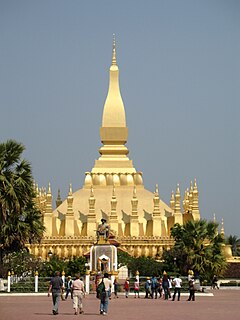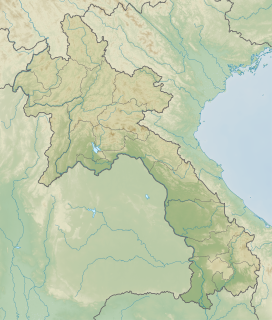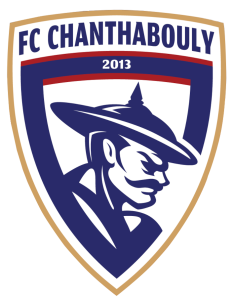Related Research Articles

Laos, officially the Lao People's Democratic Republic, is a socialist state and the only landlocked country in Southeast Asia. At the heart of the Indochinese Peninsula, Laos is bordered by Myanmar and China to the northwest, Vietnam to the east, Cambodia to the southeast and Thailand to the west and southwest.
The Lao people or Laotians are a Tai ethnic group native to Southeast Asia, who speak the eponymous language of the Kra–Dai languages, originating from present-day southern China. They are the majority ethnic group of Laos, making up 53.2% of the total population. The majority of Lao people adhere to Theravada Buddhism. They are closely related to other Tai peoples, especially with the Isan people, who are also speakers of Lao language, but native to neighboring Thailand.

Kaysone Phomvihane was the first leader of the Communist Lao People's Revolutionary Party from 1955 until his death in 1992. After the Communists seized power in the wake of the Laotian Civil War, he was the de facto leader of Laos from 1975 until his death. He served as the first Prime Minister of the Lao People's Democratic Republic from 1975 to 1991 and then as the second President from 1991 to 1992.

The Kingdom of Laos was a constitutional monarchy that served Laos beginning with its independence on 9 November 1953. The monarchy survived until December 1975, when its last king, Savang Vatthana, surrendered the throne to the Pathet Lao, who abolished the monarchy in favor of a Marxist–Leninist state called the Lao People's Democratic Republic, which has controlled Laos ever since.

The Pathet Lao, officially the Lao People's Liberation Army, was a communist political movement and organization in Laos, formed in the mid-20th century. The group was ultimately successful in assuming political power in 1975, after the Laotian Civil War. The Pathet Lao were always closely associated with Vietnamese communists. During the civil war, it was effectively organized, equipped and even led by the People's Army of Vietnam (PAVN). They fought against the anti-communist forces in the Vietnam War. Eventually, the term became the generic name for Laotian communists.

The Laotian Civil War (1959–1975) was a civil war in Laos which was waged between the Communist Pathet Lao and the Royal Lao Government from 23 May 1959 to 2 December 1975. It is associated with the Cambodian Civil War and the Vietnam War, with both sides receiving heavy external support in a proxy war between the global Cold War superpowers. It is called the Secret War among the CIA Special Activities Center and Hmong veterans of the conflict.

Lao cuisine or Laotian cuisine is the cuisine of Laos, which is distinct from other Southeast Asian cuisines.
Laotian Americans are Americans who trace their ancestry to Laos. Laotian Americans are included in the larger category of Asian Americans. The major immigrant generation were generally refugees who escaped Laos during the warfare and disruption of the 1970s, and entered refugee camps in Thailand across the Mekong River. They emigrated to the United States during the late 1970s and throughout the 1980s.

General Khamtai Siphandone is a Laotian politician who was President of Laos from 24 February 1998, until 8 June 2006, when he was replaced by Choummaly Sayasone. He was a member of the Communist Party of Indochina in 1954 and a member of the Central Committee of the Lao People's Revolutionary Party in 1956. He was the leader of the Communist Lao People's Revolutionary Party from 24 November 1992, until 21 March 2006.

Bounnhang Vorachith is a Laotian politician currently serving as President of Laos. He was previously General Secretary of the Lao People's Revolutionary Party from 2016 to 2021.

The flag of Laos consists of three horizontal stripes, with the middle stripe in blue being twice the height of the top and bottom red stripes. In the middle is a white disc, the diameter of the disc is 4⁄5 the height of the blue stripe. The flag ratio is 2:3.

The President of the Lao People's Democratic Republic is the head of state of Laos.

Theravada Buddhism is the largest religion in Laos, which is practiced by 66% of the population. Lao Buddhism is a unique version of Theravada Buddhism and is at the basis of ethnic Lao culture. Buddhism in Laos is often closely tied to animist beliefs and belief in ancestral spirits, particularly in rural areas.

Lao-Lao is a Laotian rice whisky produced in Laos. Along with Beerlao, lao-Lao is a staple drink in Laos.

The French protectorate of Laos was a French protectorate in Southeast Asia of what is today Laos between 1893 and 1953—with a brief interregnum as a Japanese puppet state in 1945—which constituted part of French Indochina. It was established over the Siamese vassal, the Kingdom of Luang Phrabang, following the Franco-Siamese War in 1893. It was integrated into French Indochina and in the following years further Siamese vassals, the Principality of Phuan and Kingdom of Champasak, were annexed into it in 1899 and 1904, respectively.

Vientiane is the capital and largest city of Laos, on the banks of the Mekong River near the border with Thailand. Vientiane became the capital in 1573, due to fears of a Burmese invasion, but was later looted, then razed to the ground in 1827 by the Siamese (Thai). Vientiane was the administrative capital during French rule and, due to economic growth in recent times, is now the economic center of Laos. The city had a population of 948,477 as of the 2020 Census.

Laotian women have long been active participants in their nation's society, involved in politics, driving social transformation and development, becoming active in the world of business and serving as nurses and food producers for the military. Due to modernization and rural uprooting, Lao women have begun to embrace lifestyles that are foreign to traditional Laotian ideals.

F.C. Chanthabouly, formerly known as Lao Toyota F.C., is a Laotian football club based in Vientiane. They compete in the Lao Premier League.
The 2016 Lao League is the 27th season of the Lao League, the top Laotian professional league for association football clubs, since its establishment in 1990. The season began on 26 March 2016, and is scheduled to conclude in late 2016.

India–Laos relations, also referred to as Indian-Lao relations or Indo-Lao relations, are bilateral relations between India and Laos. Relations between two nations were established in February 1956. First Prime Minister of India Jawaharlal Nehru visited Laos in 1954 while first President of India Rajendra Prasad visited Laos in 1956. India considers Laos as strategically important in accordance with China's growing land-reclamation activities in the South China Sea. Laos has been supportive to India's efforts to become a permanent member of the UN Security Council.
References
- ↑ "Members of the Lao Government". Lao News Agency. Archived from the original on June 3, 2011. Retrieved September 4, 2010.
| | This article about a politician from Laos is a stub. You can help Wikipedia by expanding it. |